Key takeaways
- Personal blogging serves as a creative outlet and a therapeutic practice, fostering connections through shared experiences.
- Canva simplifies the design process for bloggers by offering intuitive drag-and-drop features and a large library of templates, enhancing creativity without overwhelming the user.
- While Canva is user-friendly, it may limit uniqueness due to template commonality, and users might face challenges with layout flexibility and file quality.
- To create standout blog designs, personalize templates, prioritize simplicity, and maintain consistency with brand guidelines.
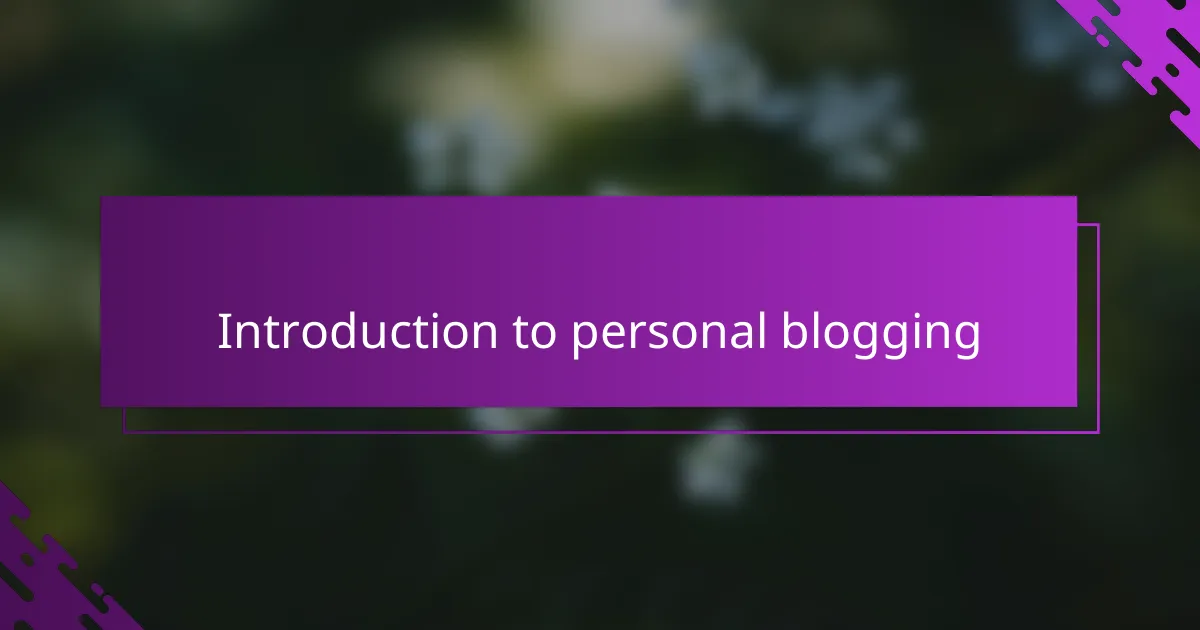
Introduction to personal blogging
Personal blogging has always felt to me like opening a small window to your world, letting others peek in and share moments that matter. Have you ever noticed how writing about your day or your thoughts can feel like a quiet conversation with a close friend? That’s the essence of personal blogging—a space where your voice is not just heard, but felt.
When I first started my blog, I didn’t realize how much it would become a mirror reflecting my growth and changes over time. It’s not just about sharing stories; it’s about connecting with people who relate to your highs and lows. Don’t you think that kind of connection is what makes personal blogging so meaningful?
Sometimes, I wonder if personal blogging could be considered both a creative outlet and a therapeutic practice. It’s fascinating how putting feelings into words can clarify thoughts and provide comfort. Has writing ever helped you make sense of your own experiences? For me, it’s been a powerful tool to navigate life’s complexities.
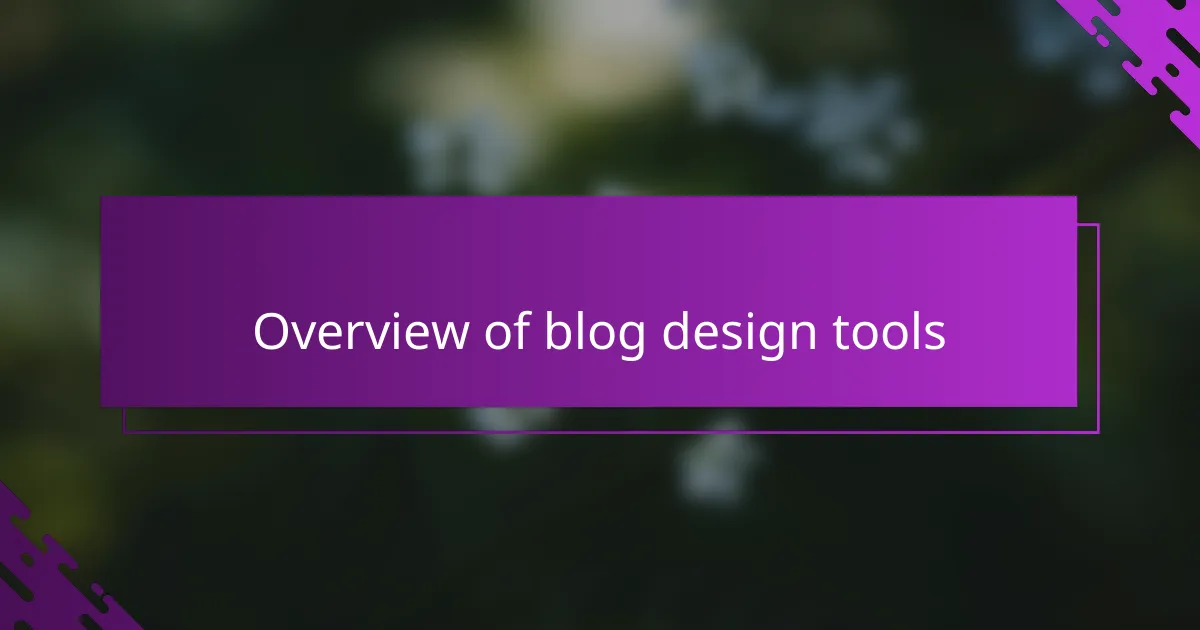
Overview of blog design tools
When I first dipped my toes into blog design, I was overwhelmed by the sheer number of tools available. From simple drag-and-drop editors to more complex platforms, each promised to make your blog look professional with minimal effort. Have you ever felt lost staring at all these options? I certainly did until I started narrowing down what really mattered for my style and workflow.
Some tools focus heavily on templates and ease of use, which is great if design isn’t your strong suit. Others offer more customization but can feel like diving into a sea of features you might never use. I’ve found that striking a balance is key—choosing a tool that feels intuitive but still gives you room to add your unique touch without frustration.
Looking back, I realize the tool I picked shaped not just the look of my blog, but how often I actually updated it. When design felt like a chore, inspiration waned. Doesn’t it make sense that the right design tool should empower you rather than slow you down? Finding the right match can transform blogging from a task into a real creative joy.
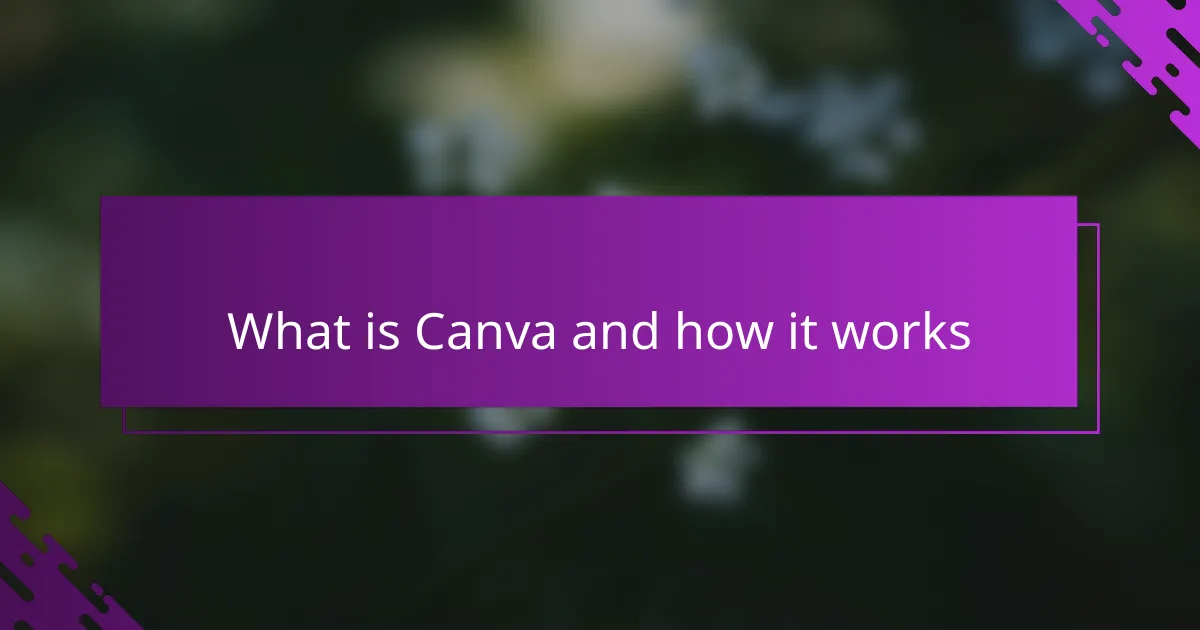
What is Canva and how it works
Canva, to me, is like having a friendly design partner right at your fingertips. It’s an online platform where you can create stunning visuals using simple drag-and-drop features, even if you’re not a design expert. Have you ever wished for a tool that just gets out of your way and lets your creativity flow? That’s exactly what Canva does.
What I appreciate most is how it offers countless templates tailored for blogs, so you don’t start from scratch. When I first tried Canva, I was amazed at how quickly I could put together headers, social media posts, and even infographics that actually looked polished. Isn’t it satisfying when a tool removes the intimidation factor and makes design feel achievable?
Behind the scenes, Canva works by providing a library of images, fonts, and design elements that you can mix and match with ease. It runs smoothly in your browser, so you don’t need heavy software on your computer. Personally, this ease of access has helped me stay consistent with my blog’s visuals without feeling overwhelmed or bogged down by complicated features.
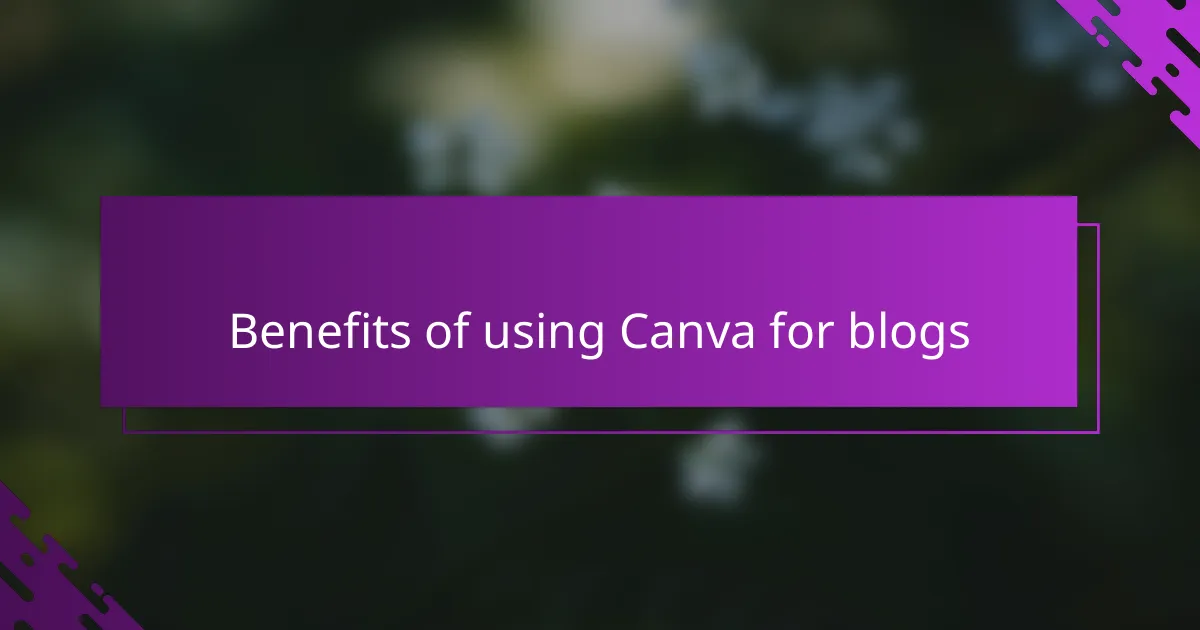
Benefits of using Canva for blogs
One of the biggest benefits I’ve found using Canva for my blog is how it streamlines the design process. Instead of spending hours fiddling with complicated software, I can quickly drag and drop elements to create visuals that feel uniquely mine. Doesn’t it feel great when design stops being a barrier and becomes part of your creative flow?
Another thing I love is the vast library of templates and design elements Canva offers. When I’m stuck on how to start, these ready-made designs spark new ideas and save me from staring blankly at a blank screen. Have you ever felt that a little guidance can make a huge difference in getting your creative juices flowing? Canva provides just that nudge without taking away your personal touch.
Finally, I have to mention how Canva keeps everything accessible and consistent. Since I can use it right in my browser, there’s no waiting for downloads or worrying about file compatibility. This ease helps me stay motivated to update my blog visuals regularly, making my content look fresh and inviting. Isn’t that the kind of tool every blogger wishes they had at their fingertips?
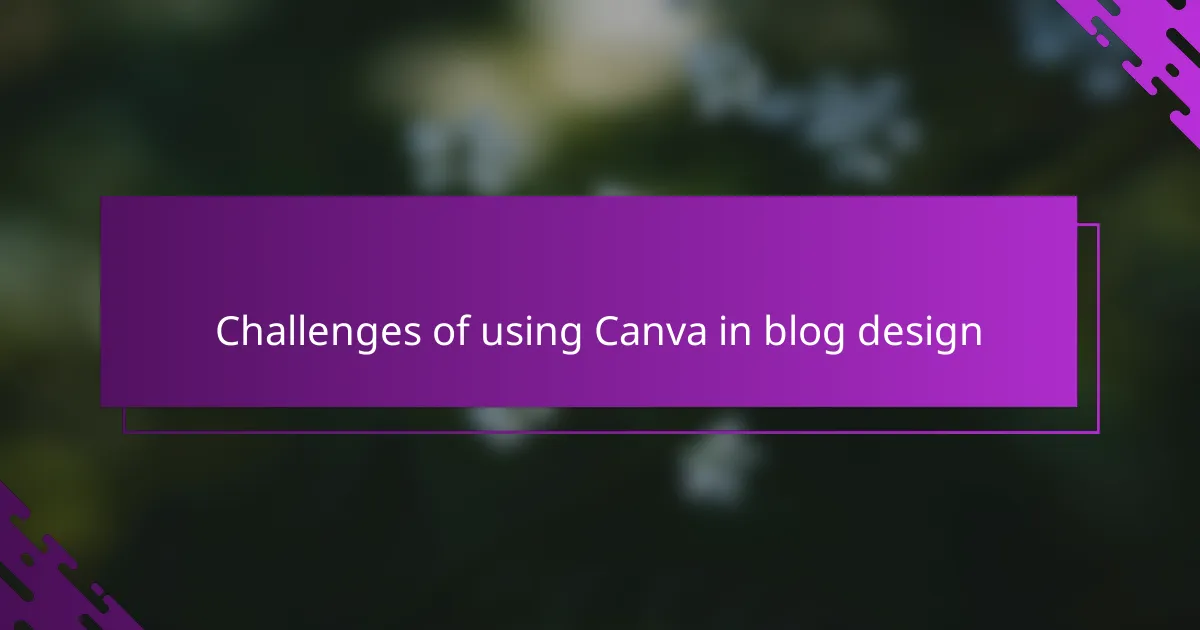
Challenges of using Canva in blog design
Although Canva feels intuitive, I’ve noticed it can sometimes limit how unique my blog designs look. Because so many users rely on the same templates and elements, it’s easy to wonder—does my blog really stand out, or is it just blending into a sea of similar styles? That’s been a bit frustrating when I want my pages to feel truly one-of-a-kind.
There are moments when Canva’s drag-and-drop simplicity becomes a bit of a double-edged sword. Sure, it’s easy to use, but I’ve found myself bumping up against restrictions in layout flexibility or advanced customization. It made me realize that even though I’m not a professional designer, sometimes I crave more control to push my blog’s look beyond the basics.
Another challenge has been managing file sizes and image quality. On occasions, I’ve created something that looked perfect on screen, only to find the final download less sharp or too large to upload smoothly. Have you ever faced that annoying disconnect between design and technical performance? It’s a reminder that even friendly tools like Canva can throw little curveballs that slow down the creative flow.

My personal experience with Canva
Using Canva for the first time felt surprisingly natural to me. I remember sitting down with zero design skills, and within minutes, I had crafted a blog header that didn’t look half bad. Isn’t it amazing when a tool makes you feel instant confidence, even if you’re a complete beginner like I was?
Over the months, Canva became my go-to for creating all kinds of visuals—from simple post images to more elaborate infographics. What struck me most was how it kept me excited about designing rather than overwhelmed. Have you ever tried a tool that just keeps you coming back because it feels more like play than work? That’s been my experience with Canva.
Of course, it’s not been perfect. Sometimes I find myself wanting to tweak things just a little more, but Canva’s limitations remind me to focus on the bigger picture rather than getting stuck on tiny details. Looking back, I realize this patience has made my blogging journey smoother and more enjoyable. Doesn’t learning when to let go make all the difference?
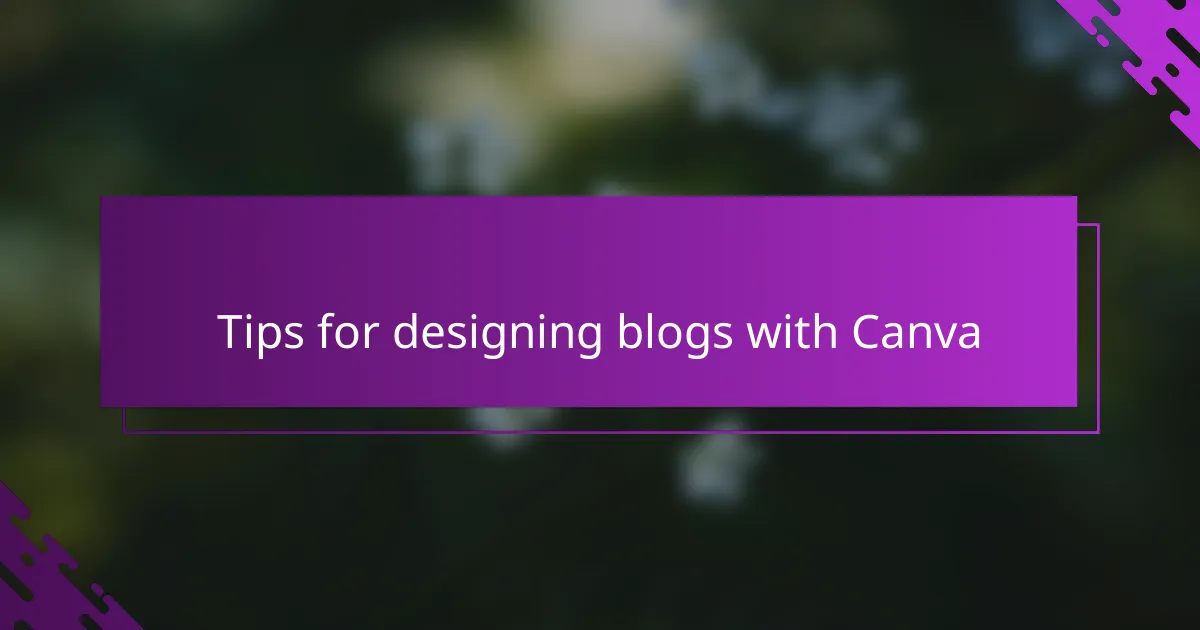
Tips for designing blogs with Canva
One tip I’ve found essential when designing blogs with Canva is to start with a template but then truly make it your own. Templates are great for inspiration, but I always tweak colors, fonts, and images to match the vibe I want my blog to convey. Have you ever felt like a design starts to feel generic? Personalizing those little details helps me avoid that and keeps my blog’s look fresh.
Another thing I can’t stress enough is to keep things simple. I used to get carried away adding too many elements, and honestly, it just made my pages look cluttered and confusing. Now, I focus on plenty of white space and clean layouts so my readers can navigate easily. Don’t you think a design that breathes lets the content shine?
Lastly, consistency has been a game changer for me. Using Canva’s brand kit feature to save my favorite fonts and colors means every post feels like it belongs to the same story. It took some trial and error, but once I locked in my style, designing became quicker and more satisfying. Have you tried setting brand guidelines for your blog? It’s one of those small steps that pays off big over time.
